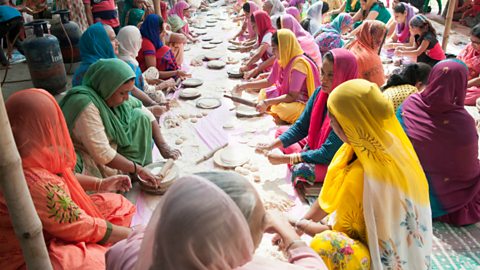Sewa
sewaSelfless service to the community. means тselfless serviceт. It involves acting selflessly and helping others in a variety of ways, without any reward or personal gain. It is a way of life for many Sikhs and is part of their daily routine. Sikhism teaches that sewa is an act of service towards WaheguruSikhs believe in one God called Waheguru which means тWonderful Lordт or тWonderful Teacherт. and therefore must be done regularly in order to become closer to Waheguru. It helps Sikhs to become gurmukhGod-centred, living by the Gurus' teachings. and show their faith towards Waheguru.
Sikhs perform sewa in a variety of ways, such as helping the sangatCongregation in a Sikh gurdwara. and the local community. Many Sikhs perform much of their sewa by helping at the gurdwaraSikh place of worship. Literally, the 'doorway to the Guru'., including cleaning, washing dishes or serving in the langarThe kitchen and place where food is eaten in a Sikh Gurdwara. Often volunteers provide and cook food that is served to all as an act of sewa (charity)..

Performing sewa is important because:
- It demonstrates belief in equality and the importance of all people.
- By serving others, Sikhs show humility. This is because serving others shows that Sikhs do not believe they are better than anyone else.
- Showing love and respect by helping others shows love for Waheguru.
- It helps Sikhs to become more gurmukh. This is because it helps them to develop the virtues of truth and truthful living, compassion and patience, contentment, humility and self-control, love, and wisdom and courage.
- It stops Sikhs from becoming manmukhSelf-centred., because their focus is on the needs of others rather than themselves.
- It helps Sikhs to move away from the five vicesFive emotions that can take over a person's life and lead them to actions they later regret: anger, pride, lust, greed and undue attachment. of anger, pride, lust, greed and attachment to material possessions.
One who performs selfless service, without thought of reward, shall attain his Lord and Master.
Types of sewa
There are three types of sewa. These are tan, man, dhanGood service (sewa) for others which includes the physical (tan), mental (man) and material (dhan.).
| Tan | Physical aspect of sewa | This involves physical work and tasks to show selfless service. For example, this could be cooking or serving in the langar, cleaning the gurdwara or helping with gardening. |
| Man | Mental aspect of sewa | This involves a Sikh using their mental skills and talents. For example, this could be teaching people how to read or understand the Guru Granth Sahib, teaching people how to play the musical instruments used during worship or teaching people about the history of Sikhism. |
| Dhan | Material aspect of sewa | This involves Sikhs selflessly helping others by sharing their material wealth. This could be donating one tenth of their income to the sangat or to charities, which is known as daswandh. It could also involve helping others in times of financial difficulty or giving money to the poor. |
| Tan |
| Physical aspect of sewa |
| This involves physical work and tasks to show selfless service. For example, this could be cooking or serving in the langar, cleaning the gurdwara or helping with gardening. |
| Man |
| Mental aspect of sewa |
| This involves a Sikh using their mental skills and talents. For example, this could be teaching people how to read or understand the Guru Granth Sahib, teaching people how to play the musical instruments used during worship or teaching people about the history of Sikhism. |
| Dhan |
| Material aspect of sewa |
| This involves Sikhs selflessly helping others by sharing their material wealth. This could be donating one tenth of their income to the sangat or to charities, which is known as daswandh. It could also involve helping others in times of financial difficulty or giving money to the poor. |
All three aspects of sewa are equally important. Sikhs try to complete all three aspects of sewa on a regular basis. However, depending on an individualтs circumstance, a Sikh might be able to perform one type of sewa more than the others.
Through selfless service, eternal peace is obtained.